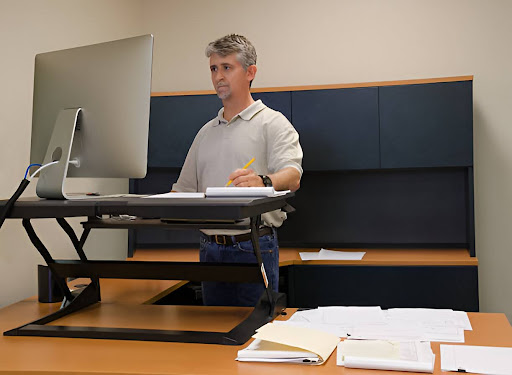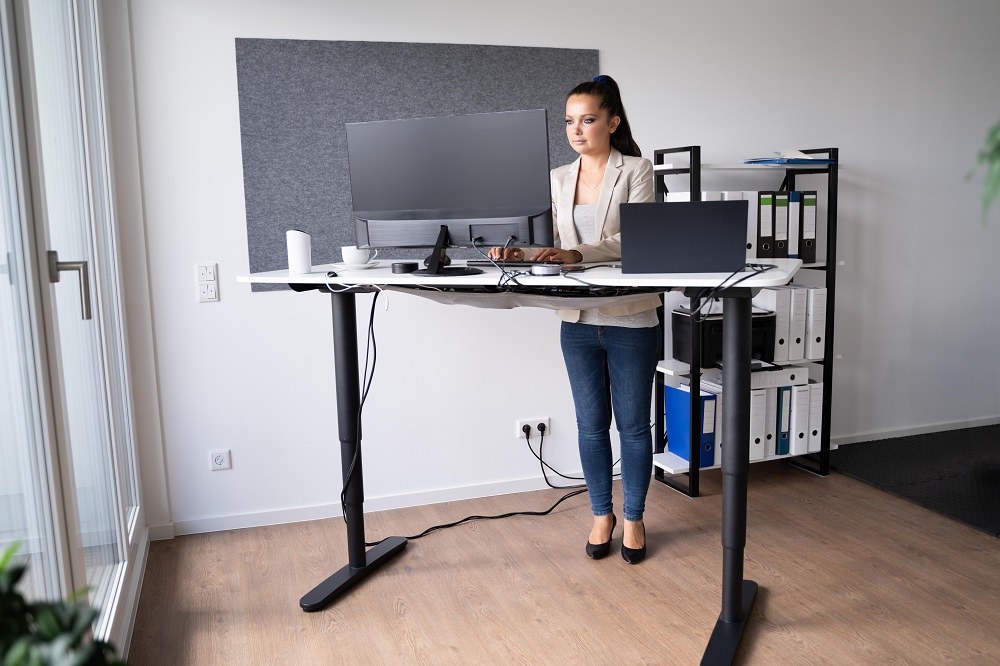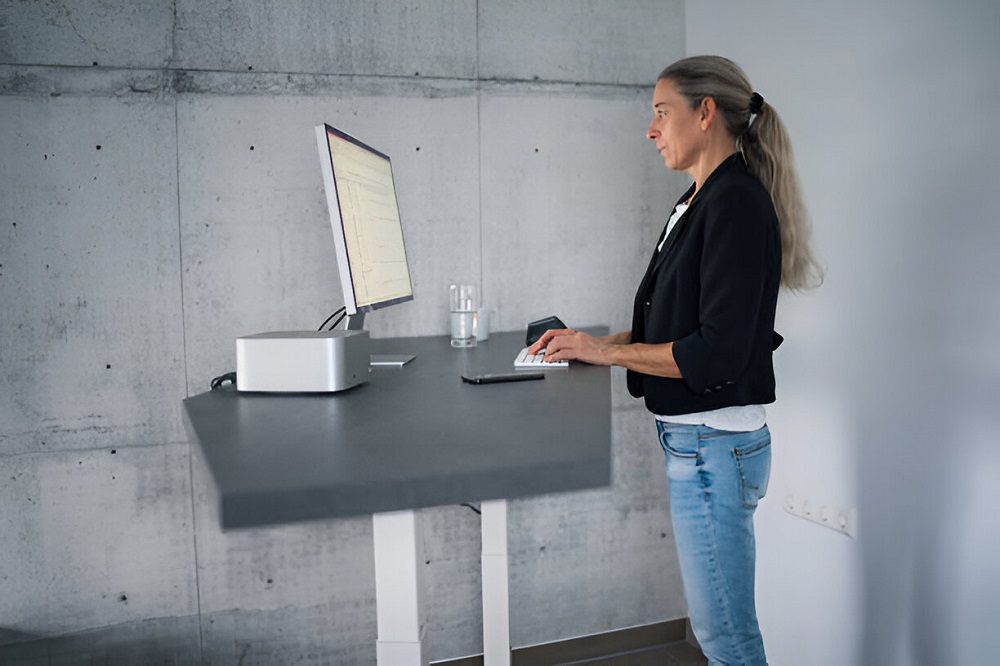Introduction
Do you often experience pain in your back and arms? It might be because you work while sitting in one spot for hours. Most working professionals dread working long hours in a sitting position.
A 2015 study found that people in the United Kingdom spend 60% of their active hours sitting down. However, that number rises to an astounding 75% for office employees!
Sitting continuously for long periods puts extra stress on the body, exacerbates fatigue, and has been considered the unhealthiest body position. Unfortunately, maximum job roles demand most of the time at a desk.
Luckily, there is an innovative solution: you can convert your desk into an ergonomic standing desk to work without sitting for long hours.
Why Should You Reduce Sitting Time?
It's common to become preoccupied with tight work schedules and spend hours stuck to our chairs. However, it's essential to recognize some health hazards associated with the sedentary lifestyle.
Prolonged sitting has fretting repercussions, which range from bad posture and weight gain to serious health concerns.
Let's look at why you should decrease the sitting time and what are the risks to your health of sitting for long hours.
-
Weight Gain:
If you sit for long hours, you are more likely to be overweight and develop serious health concerns. Prolonged sitting isn't just a lack of activity; it's actively harmful to the body.
Sitting for extended periods causes your body to burn fewer calories than when moving, leading to weight gain. Furthermore, sitting for extended hours could hamper your metabolism, making it difficult to maintain a healthy weight.
-
Bad Posture
Imagine yourself bent forward at a desk, shoulders rounded, and neck strained. Does that sound similar to what you do every day? Many of us adopt that posture when sitting for hours.
Unfortunately, bad posture can cause muscle problems, stiffness, and chronic discomfort, particularly in the neck, shoulders, and lower back.
-
Hazardous Health Risks
Perhaps most concerning are the health concerns connected with prolonged sitting. Studies have found that extended sitting increases the risk of heart-related diseases, type 2 diabetes, and even certain types of cancer.
Sedentary lifestyles, such as sitting in one place for a longer period, can result in high blood pressure, elevated blood sugar levels, and varying cholesterol levels, all of these are risk factors for severe health problems.
A study found that participants (447 Iranian office employees) spent an average of 6.29 hours sitting during an 8-hour shift. Nearly half (48.8%) reported being uncomfortable at their workstations, and a 73.6% endure exhaustion throughout the day.
Furthermore, 6.3% experienced hypertension, and 11.2% had hyperlipidemia. The results revealed that neck (53.5%), lower back (53.2%), and shoulder (51.6%) issues were the most common among office workers.
Understanding Sit-Stand Desks
Standing encourages movement and non-conscious twisting, which increases blood flow, energy, attention, and reduces the need for a constant caffeine intake to stay awake.
Standing is one of the healthiest positions since it improves your posture, which can reduce the risk of back, neck, and shoulder problems. Not slouching has been demonstrated to help people appear younger, leaner, fitter, and overall healthier.
Improved posture also reduces the likelihood of acquiring long-term impairments like arthritis and cancer. So, using sit-stand desks, also known as height-adjustable desks, improves circulation, allowing you to feel energized rather than exhausted at the end of the day.
These innovative desks address the risks of extended sitting by allowing workers to switch positions throughout their work day. The standing desks promote mobility, increase circulation, and minimize the adverse effects of sitting in a bad posture by allowing you to switch between sitting and standing positions.
What does it do?
With a sit-stand desk, you no longer have to sit in a static position for hours. Instead, you can customize your workstation to accommodate your requirements and preferences, such as sitting to focus on a task or standing to brainstorm ideas during a meeting.
- Provides comfort
- Improves good posture
- Promotes overall health
Benefits of Adjustable Height Desks
A height-adjustable standing desk is a new solution that aims to change the traditional workplace into a dynamic one that values both physical well-being and performance, allowing you to work in both standing and seated positions.

These desks have numerous benefits, from combating the sedentary lifestyle to increasing energy levels and productivity.
Let's look at some of the benefits:
-
Combating Sedentary Lifestyle
Health professionals are concerned about the sedentary lifestyle associated with conventional desk settings, which is a significant threat to health. An adjustable-height standing deskcan successfully combat sedentary behavior.
Shifting between sitting and standing postures throughout the day adds movement to your routine and can significantly reduce the health hazards of extended sitting. This active approach to work engages your body and increases energy and mental attentiveness.
-
Boosting Energy & Productivity
Have you ever had a mid-afternoon slump when your energy levels drop and focus becomes elusive? Adjustable-height desks provide a solution.
Standing periodically while working stimulates circulation and increases oxygen flow throughout your body, reducing exhaustion and revitalizing your thoughts. Sit-stand desk boosts productivity and happiness in employees.
Employees can feel more energized, focused, and productive when working at standing desks, suggesting that this innovation is good for health. The rush of energy caused by constantly switching between standing and sitting leads to increased productivity and attention, allowing you to approach tasks with fresh energy and efficiency.
-
Ergonomic Bliss
In terms of workplace ergonomics, one size does not fit all. Each person has different height preferences and posture needs. An adjustable standing desk allows you to tailor your workstation to suit your height.
Adjusting the workstation to the correct height promotes ideal alignment of the spine, shoulders, and wrists, lowering the possibility of strain and discomfort.
The ergonomic perfection allows you to work comfortably for long periods without risking your health.
-
Reducing Back Pain
Chronic back pain is prevalent among office workers and is often attributed to prolonged and bad sitting postures. Standing desk and back pain are inversely proportional. Using a standing desk reduces the chances of back pain while keeping your spine straight.
Adjustable height desks offer relief by allowing you to stand intermittently throughout the day, relieving pressure on the spine, and supporting better posture.
Extended standing periods into your routine strengthens core muscles and alleviates back strain, reducing the likelihood of developing or exacerbating back pain.
-
Requirement-based Tailoring
Adjustable-height desks can adapt to your natural rhythm and preferences, making them ideal for tailoring work to your needs. Standing desks can also fit your requirements, whether you're a morning person who likes to stand while working or prefers to sit during heavy focus periods.
A standard Ergonomic standing desk adjusts height and raises objects, allowing you to work comfortably while standing. The best standing desk will include several sections if you work on a laptop or a desktop.
One section can raise your screen to eye level, another will hold your keyboard and mouse in an ergonomic position, and another will serve as your standard work surface.
To reap the benefits of good posture, avoid slouching your shoulder while looking down at a computer screen; instead, raise the screen to stand up straight and look forward naturally without slouching.
The personalized approach to the work environment improves comfort, productivity, and overall well-being, allowing you to perform at your best throughout the day.
Transitioning to a Height-Adjustable Desk
-
Gradual Adjustment
Moving to a height-adjustable desk is a journey, not an overnight change. Begin by gradually incorporating standing periods into your work schedule. Begin with short periods of standing, such as 15 to 30 minutes at a time, and gradually increase the duration as your body adapts.
Listen to your body's instincts and take breaks to avoid overexertion. This progressive approach allows your muscles and joints to adjust to the change in posture while reducing the chance of soreness.
-
Personalization
One of the primary benefits of height-adjustable desks is their versatility. They allow you to customize your workspace to meet your needs and preferences. Experiment with different standing and sitting intervals to find your ideal balance.
Purchase comfortable footwear with adequate arch support and cushioning to relieve stress on your feet and joints. An anti-fatigue mat placed beneath your desk can also give extra cushioning and support, minimizing discomfort during extended standing periods.
By personalizing your workplace and listening to your body's feedback, you can optimize your transition to a height-adjustable desk and get the full benefits of a more dynamic work environment.
Conclusion
Hence, height-adjustable desks provide a dynamic solution to the problems caused by prolonged sitting in an unusual position. Incorporating standing breaks into your workday can boost your productivity and general wellness.
Remember to listen to your body and make necessary changes to establish a workspace that promotes your health. Stand up to work and benefit from a more dynamic and ergonomic approach to productivity.




